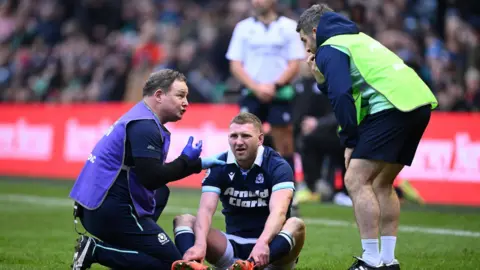Height of lower equipment connected to the fall in the collisions of the head

BBC Scotland News
 PA medium
PA mediumBy lowering the height of the equipment in male rugby he almost halved the head of collisions of the head among the players, he discovered a study at the University of Edinburgh.
The law on the height of the lowered equipment was introduced for the rugby community by World Rugby in the 2023/24 season in an attempt to improve security for players.
Researchers from the University of Edinburgh used video analysis to study the contracts of 60 matches of the male community in Scotland before the trial and during it, and discovered that the modification of the law involved a 45% reduction in the head-theater contact.
Experts previously found contacts head each was one of the main causes of cerebral emotion relating to sport.
 Getty images
Getty imagesBoth the Rugby Union and the Rugby League authorities are facing Legal action in progress from former players who have undergone brain injuries.
The study-that examined 18,702 contrasts-also connected the modification of the law to a 29% reduction in the head of the head for the striker and the ball carrier.
During the trial period in the 2023/24 season, the players of the season had 22% more likely to face life, the recommended technique to reduce the closeness and contact of the player’s head.
Dr. Debbie Palmer, of the Institute for Sport, Physical Education and Health Sciences at the Moray House School of Education and Sport, and the co-director of the UK collaborative center on injuries and disease prevention in the Cio Cio Cio Cio Center, said that the results are “very encouraging”.
The main author of the study, Hamish Gornall – of the Moray House School of Education and Sport of the University of Edinburgh – added that the study showed that the change of the rules had proved to be “effective” in altering the deal of adding.
He added: “The collection of potential data on lesions, as well as a continuous monitoring of the players’ behavior in the following seasons would be useful to further investigate the implications of change”.
World Rugby Trial
The study is part of an international project led by World Rugby To evaluate the effects of reducing the height of the equipment in a series of countries, including France, New Zealand and Australia.
The researchers have not found any significant increase in the heads of platelets that come into contact with the sides or knees of the ball wagons, which is associated with an increased risk of evaluations of the head injuries and diagnosis of brain emotion.
The process was adopted by Scottish rugby and made mandatory in all amateur game levels.
Dr. David Pugh, Chief Medical Officer of Scottish Rugby, said: “At Scottish rugby we strive to reduce the incidence of the brain emotion in as many way possible.
“We are also working with the university for an injuries for injuries and we hope this will see a significant drop in brain emotion rates due to the test test of lower equipment.
“Hamish’s research clearly shows that players’ behaviors have changed, reducing head contacts and heads to shoulders that should lead to a reduced number of brain commodities in our players.”
In 2023 A study on the brain of former Glasgow University rugby players Discovered that on 31 donated brains analyzed, 21 had evidence of a condition linked to repeated head injuries and brain emotion.
A Durham University study last year The suggested rugby players who have undergone more cerebral emotions have biological differences that can make them more inclined to the development of the motorway disease (MNN) – the condition from which the former Scottish internationalist Doddie Weir died.
More than 1,000 former Amateur and Professional Rugby Union and Rugby League players are currently involved in a cause of long -standing brain emotion against the sports bodies of sport.





